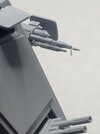Hello, this is my first post. I'm new to this hobby and have completed building a Star Wars 1/44 scale AT-ST. One of the guns on the side is rather delicate and has partially broken. Is there a proven, reliable way to reinforce it so that it won't break off at the slightest bump? Please see the attached photo; the arrow is pointing at the spot where it's partially detached. Any chance the eventual varnish coat will reinforce it? I've brushed some extra thin cement onto it but it is still moving at the slightest touch.
Thanks in advance.
I look forward to browsing this forum in the near future. I'm currently in possession of an 1980 MPC snowspeeder, an 1989 MPC AT-AT, MPC R2-D2, MPC C-3PO, 2 Bandai X-Wings, 2 A-Wings, 2 AT-ATs, a Y-Wing, a TIE Advanced X1, and a perfect grade Millennium Falcon, so it's time to get to work!

Thanks in advance.
I look forward to browsing this forum in the near future. I'm currently in possession of an 1980 MPC snowspeeder, an 1989 MPC AT-AT, MPC R2-D2, MPC C-3PO, 2 Bandai X-Wings, 2 A-Wings, 2 AT-ATs, a Y-Wing, a TIE Advanced X1, and a perfect grade Millennium Falcon, so it's time to get to work!

